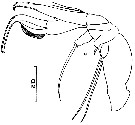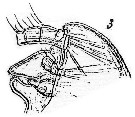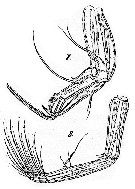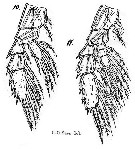|
|
 |
Fiche d'espèce de Copépode |
|
|
Calanoida ( Ordre ) |
|
|
|
Clausocalanoidea ( Superfamille ) |
|
|
|
Aetideidae ( Famille ) |
|
|
|
Chiridiella ( Genre ) |
|
|
| |
Chiridiella macrodactyla Sars, 1907 (F) | |
| | | | | | | Syn.: | no Chiridiella macrodactyla : A. Scott, 1909 (p.79, figs.F); no Farran, 1908 b (p.46, figs.F); no Tanaka, 1957 a (p.57, figs.F); Tanaka & Omori, 1970 b (p.153);
? C. abyssalis : Johnson, 1963 (p.92, fig.F) | | | | Ref.: | | | Sars, 1907 (p.8, Descr.F); Sars, 1925 (p.50, figs.F); Farran, 1926 (p.248); Rose, 1933 a (p.95, figs.F); Lysholm & al., 1945 (p.16); Vervoort, 1952 c (n°44, p.3, figs.F,M); Østvedt, 1955 (p.14: Table 3); Vervoort, 1963 b (p.156, Rem.); Bradford, 1971 b (p.21, Rem.); Deevey, 1974 (p.456, 458, 469, figs.F); Markhaseva, 1996 (p.99, figs.F, Rem.); Chihara & Murano, 1997 (p.683, Pl.33: F); Boxshall & Halsey, 2004 (p.59: fig.F); Vives & Shmeleva, 2007 (p.557, Rem.F) |  issued from : E.L. Markhaseva in Proc. Zool. Inst. RAN, St. Petersburg, 1996, 268. [p.100, Figs.74, 75]. Female (from Sars, 1924); A, B, C, D from specimen of N Atlant. (from Markhaseva, 1996).
|
 issued from : G.A. Deevey in Bull. Mar. Sc., 1974, 24 (2). [p.464, Fig.15]. Female (from 32°10'N, 64°10'W): a, habitus (lateral); b, A2; c, Mxp (endopod setae not shown); d, Md; e, P1; f, P2; g, P4; h, P3; i, Mx1; j, Mx2. Scale on left margin for part a; at lower right for parts b-j. Scales in mm. Nota : For Deevey (1974, p.465) it is some hesitation that the specimenns are identified as C. macrodactyla
|
 issued from : G.A. Deevey in Bull. Mar. Sc., 1974, 24 (2). [p.464, Fig.15]. Female (from 32°10'N, 64°10'W): a, habitus (lateral); b, A2; c, Mxp (endopod setae not shown); d, Md; e, P1; f, P2; g, P4; h, P3; i, Mx1; j, Mx2. Scale on left margin for part a; at lower right for parts b-j. Scales in mm.
|
 issued from : G.A. Deevey in Bull. Mar. Sc., 1974, 24 (2). [p.467, Fig.17c]. Female: c, Mx2. Scale in mm.
|
 Chiridiella macrodactyla Chiridiella macrodactyla female: 1 - Mx2 with 5 endites. 2 - Mx2 strongly modified in comparison with typical; first-fifth endites of varying size; Setation is not typical, some number of setae on third-fifth endites transformed into pincers-like spines. 3 - Setae of fourth endite of Mx2 arranged like pincers. 4 - Endopodal segment 2 of Md with 3 setae. Mx1 with exopod, exopod with 4 setae. 5 - Protopodite of Mxp with 2 setae in distal group. 6 - P3-P4 with 3-segmented rami.
|
 Issued from: G.O. Sars in Résult. Camp. Scient. Prince Albert I, 69, pls.1-127 (1924). [Pl.XVI, figs. 1, 2, 9]. Female (from Azores Islands): 1-2, habitus (dorsal and lateral, respectively); 9, P1.
|
 Issued from: G.O. Sars in Résult. Camp. Scient. Prince Albert I, 69, pls.1-127 (1924). [Pl.XVI, fig. 3]. Female: 3, forehead (left lateral view), showing prominent labium and labium..
|
 Issued from: G.O. Sars in Résult. Camp. Scient. Prince Albert I, 69, pls.1-127 (1924). [Pl.XVI, figs. 4, 5, 6]. Female: 4, A2; 5, Md; 6, Mx1.
|
 Issued from: G.O. Sars in Résult. Camp. Scient. Prince Albert I, 69, pls.1-127 (1924). [Pl.XVI, figs. 7, 8]. Female: 7, Mx2; 8, Mxp.
|
 Issued from: G.O. Sars in Résult. Camp. Scient. Prince Albert I, 69, pls.1-127 (1924). [Pl.XVI, figs. 10, 11]. Female: 10, P2; 11, P4.
|
 Chiridiella macrodactyla Chiridiella macrodactyla female ; 1 - Penultimate lobe of Mx2 with 1 long and 1 short spine arranged as pincers. 2 - Mx2 with 4 or 5 lobes. 3 - A1 not extending beyond genital segment. 4 - Proximal lobe of Mx2 with 2 long setae. 5 - 1st basipod segment of Mxp with 2 distal setae, 2nd segment with 3 setae.
| | | | | Ref. compl.: | | | Damas & Koefoed, 1907 (p.400, tab.II); Østvedt, 1955 (p.14: Table 3, p.61); Sewell, 1948 (p.499, 546, 550); C.B. Wilson, 1950 (p.188); De Decker & Mombeck, 1964 (p.11); Grice & Hulsemann, 1965 (p.223); 1967 (p.14); Roe, 1972 (p.277, tabl.1, tabl.2); Björnberg, 1973 (p.323, 38); Deevey & Brooks, 1977 (p.256, Table 2, station "S"); Vives, 1982 (p.291); Lozano Soldevilla & al., 1988 (p.58); Shih & Young, 1995 (p.66); Suarez-Morales & Gasca, 1998 a (p.107) | | | | NZ: | 7 + 2 douteuses | | |
|
Carte de distribution de Chiridiella macrodactyla par zones géographiques
|
| | | | | | | | | | Loc: | | | South Africa (E), G. of Guinea, off Morocco-Mauritania, Canary Is., W Africa, Brazil, Azores, Caribbean Sea, Sargasso Sea, Station "S" (32°10'N, 64°30'W), Bay of Biscay, ? W Ireland, ? Norway Sea, Indian, ? Halmahera Sea, China Seas (South China Sea), N Chile.
Type locality Azores Islands. | | | | N: | 20 | | | | Lg.: | | | (1) F: 2,7; (14) F: 3-2,6; (37) F: 2,65-2,35; (38) F: 2,8-2,56; (199) F: 2,66-2,58; {F: 2,35-3,00} | | | | Rem.: | méso-bathypélagique.
Certaines localisations seraient douteuses (notamment dans le Pacifique).
Pour Deevey (1974) et Markhaseva (1996) l'espèce signalée sous ce nom par Farran (1908 b) n'est pas correcte.
Voir aussi les remarques en anglais | | | Dernière mise à jour : 02/09/2021 | |
|
|
 Toute utilisation de ce site pour une publication sera mentionnée avec la référence suivante : Toute utilisation de ce site pour une publication sera mentionnée avec la référence suivante :
Razouls C., Desreumaux N., Kouwenberg J. et de Bovée F., 2005-2025. - Biodiversité des Copépodes planctoniques marins (morphologie, répartition géographique et données biologiques). Sorbonne Université, CNRS. Disponible sur http://copepodes.obs-banyuls.fr [Accédé le 21 octobre 2025] © copyright 2005-2025 Sorbonne Université, CNRS
|
|
 |
 |











